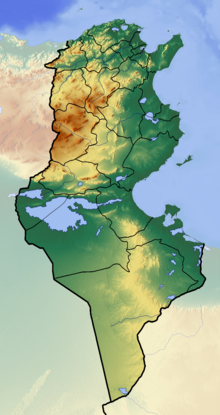
Tunis is the capital and largest city of Tunisia. The greater metropolitan area of Tunis, often referred to as "Grand Tunis", has about 2,700,000 inhabitants. As of 2020, it is the third-largest city in the Maghreb region and the eleventh-largest in the Arab world.
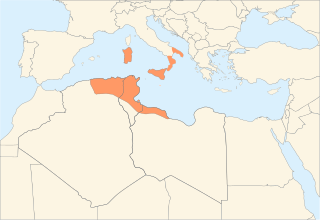
The Aghlabid dynasty was an Arab dynasty centered in Ifriqiya from 800 to 909 that conquered parts of Sicily, Southern Italy, and possibly Sardinia, nominally as vassals of the Abbasid Caliphate. The Aghlabids were from the tribe of Banu Tamim and adhered to the Mu'tazilite rationalist doctrine within Hanafi Sunni Islam, which they imposed as the state doctrine of Ifriqiya. They ruled until 909 when they were conquered by the new power of the Fatimids.

Abu Zakariya Yahya (Arabic: أبو زكريا يحيى بن حفص, Abu Zakariya Yahya I ben Abd al-Wahid was the founder and first sultan of the Hafsid dynasty in Ifriqiya. He was the grandson of Sheikh Abu al-Hafs, the leader of the Hintata and second in command of the Almohads after Abd al-Mu'min.

Abu al-Hasan al-Shadhili also known as Sheikh al-Shadhili was an influential Moroccan Islamic scholar and Sufi, founder of the Shadhili Sufi order.

Al-Zaytuna Mosque, also known as Ez-Zitouna Mosque, and El-Zituna Mosque, is a major mosque at the center of the Medina of Tunis in Tunis, Tunisia. The mosque is the oldest in the city and covers an area of 5,000 square metres with nine entrances. It was founded at the end of the 7th century or in the early 8th century, but its current architectural form dates from a reconstruction in the 9th century, including many antique columns reused from Carthage, and from later additions and restorations over the centuries. The mosque hosted one of the first and greatest universities in the history of Islam. Many Muslim scholars graduated from al-Zaytuna for over a thousand years. Ibn 'Arafa, a major Maliki scholar, al-Maziri, the great traditionalist and jurist, and Aboul-Qacem Echebbi, a famous Tunisian poet, all taught there, among others.

The Medina of Tunis is the medina quarter of Tunis, the capital of Tunisia. It has been a UNESCO World Heritage Site since 1979.
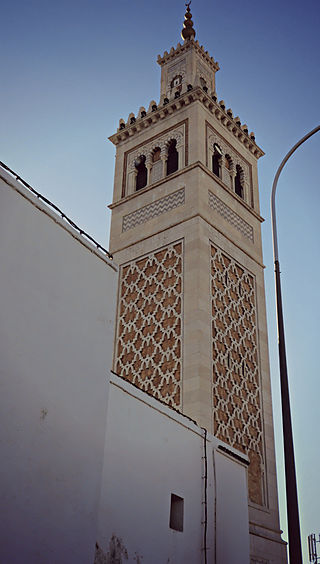
Bab Jazira Mosque also known as El Jenaïz mosque is a mosque in Tunis, Tunisia.
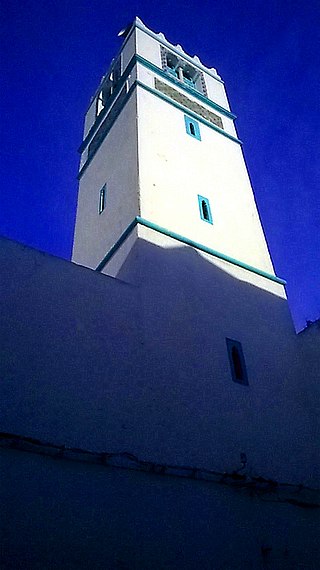
Hajjamine Mosque is a mosque in Tunis, Tunisia, located in the Beb jedid arrondissement. The mosque was restored by cheikh El Haj Ahmed Ben Lamine in 1931.

Sabkha Mosque is a Tunisian mosque in the south of the medina of Tunis in Bab Jaziza suburb.

El Jedid Mosque is a mosque in Tunis, Tunisia, located in Medina area of the city.
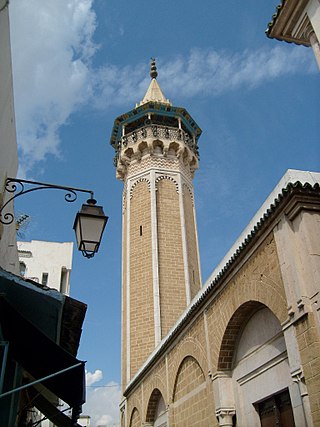
Hammouda Bay Mosque or Hamouda Bay al Mouradi is a mosque in Tunis, Tunisia. It is an official historical monument.

Sidi Mahrez Mosque, also known as Mohamed Bey El Mouradi Mosque, is a mosque in Tunis, Tunisia. It is an official historical monument.
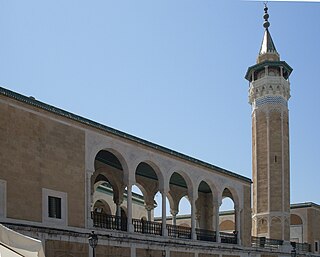
Saheb Ettabaâ Mosque, also known as Youssef Saheb Al Tabaa Mosque, is a mosque in Tunis, Tunisia, located in the Halfaouine area of the city. It is an official Historical Monument. It is the last great mosque built in Tunis before the establishment of French protectorate in 1881.
The following is a timeline of the history of the city of Tunis, Tunisia.

The Banu Khurasan or Khurasanid dynasty was a Sunni Muslim dynasty that ruled an independent principality centered on Tunis, in present-day Tunisia, between approximately 1058 and 1159. They rose to power following the political vacuum left behind by the Zirids when they abandoned Kairouan for Mahdia in 1157, in the face of pressure from the Banu Hilal. While de facto independent, they continued to recognize the suzerainty of either Zirids or the Hammadids for much of this period. Their rule was interrupted by Hammadid annexation from 1128 and 1148, and their authority came to a final end with the Almohad conquest in 1159.
Madrasa Slimania is a former madrasa and one of the monuments of the Ottoman era in the medina of Tunis.

Laz Mosque is a small mosque in the west of the medina of Tunis.

Madrasa Andaloussiya also known as the Madrasa El Younsiya, is a tunisian Madrasah in the Medina of Tunis. It also called Madrasa of Sidi El Ajmi because it is close to his zaouia.

Madrasa El Mountaciriya, also known as Madrasa Al Fath is one of the madrasahs of the medina of Tunis.

